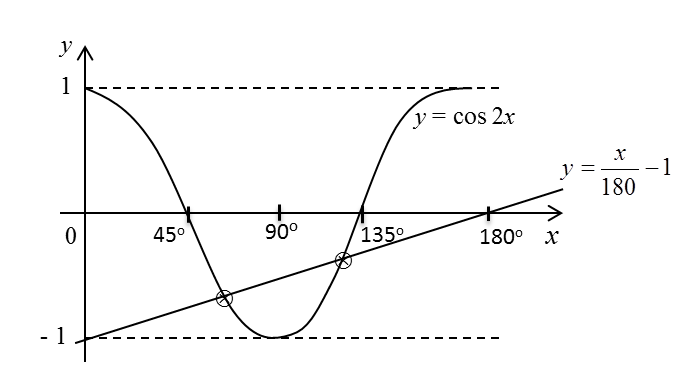(D) Solving Trigonometric Equations (Involving Addition Formulae and Double Angle Formulae)
Example 1 (Addition Formulae):
Solve the following equation for 0o ≤ x ≤ 360o:
(a) sin ( x – 25o) = 3 sin ( x + 25o)
(b) 3 cos ( 2x + 10o) = 2
Solution:
(a)
sin ( x – 25o) = 3 sin ( x + 25o)
sin x cos 25o – cos x sin 25o = 3 (sin x cos 25o + cos x sin 25o)
sin x cos 25o – cos x sin 25o = 3 sin x cos 25o + 3 cos x sin 25o
– sin x cos 25o = 4 cos x sin 25o
tan x = – 2 tan 25o
tan x = – 2 (0.4663)
tan x = – 0.9326
basic angle x = 43o
The reference angles of x = 43o are in the second and fourth quadrants.
Hence, x = 180o – 43o, 360o – 43o
x = 137o , 317o
(b)
3 cos ( 2x + 10o) = 2 ← (Take the angles in the range of 0o ≤ x ≤ 720o, which in 2 complete revolutions)
cos ( 2x + 10o) = ⅔
basic angle ( 2x + 10o) = 48.19o
2x + 10o = 48.19o, 360o – 48.19o , 360o + 48.19o, 720o – 48.19o
2x + 10o = 48.19o, 311.81o , 408.19o, 671.81o
2x = 38.19o, 301.81o , 398.19o, 661.81o
x = 19.10o, 150.91o , 199.10o, 330.91o
Example 2 (Double Angle):
Find all the angles that satisfy the equation 5 cos 2A + 9 sin A = 7,
0° < A < 360°.
Solution:
5 cos 2A + 9 sin A = 7
5 (1 – 2 sin2A) + 9 sin A = 7 ← (substitution of cos 2A = 1 – 2 sin²A is used. Then the whole equation will be in terms of sin A)
5 – 10 sin2A + 9 sin A – 7 = 0
– 10 sin2A + 9 sin A – 2 = 0
10 sin2A – 9 sin A + 2 = 0
(2 sin A – 1)(5 sin A – 2) = 0 ← (Factorise)
sin A = ½ = 0.5 or sin A=
= 0.4
When sin A = 0.5,
Basic angle = 30º
A = 30º, 180º – 30º
A = 30º, 150º
When sin A = 0.4,
Basic angle = 23.58º
A = 23.58º, 180º – 23.58º
A = 23.58º, 156.42º
Hence A = 23.58º, 30º, 150º, 156.42º.
Example 3 (Double Angle):
Find all the possible values of θ between 0 and 2π rad for the equation sin 2θ = sin θ
Solution:
sin 2θ = sin θ
2 sin θ cos θ = sin θ ← (sin 2θ = 2 sin θ cos θ)
2 sin θ cos θ – sin θ = 0
sin θ (2 cos θ – 1) = 0 ← (Factorise)
sin θ = 0 or 2 cos θ – 1 = 0
When sin θ = 0
θ = 0, π, 2π
When 2 cos θ – 1= 0
cos θ = ½

